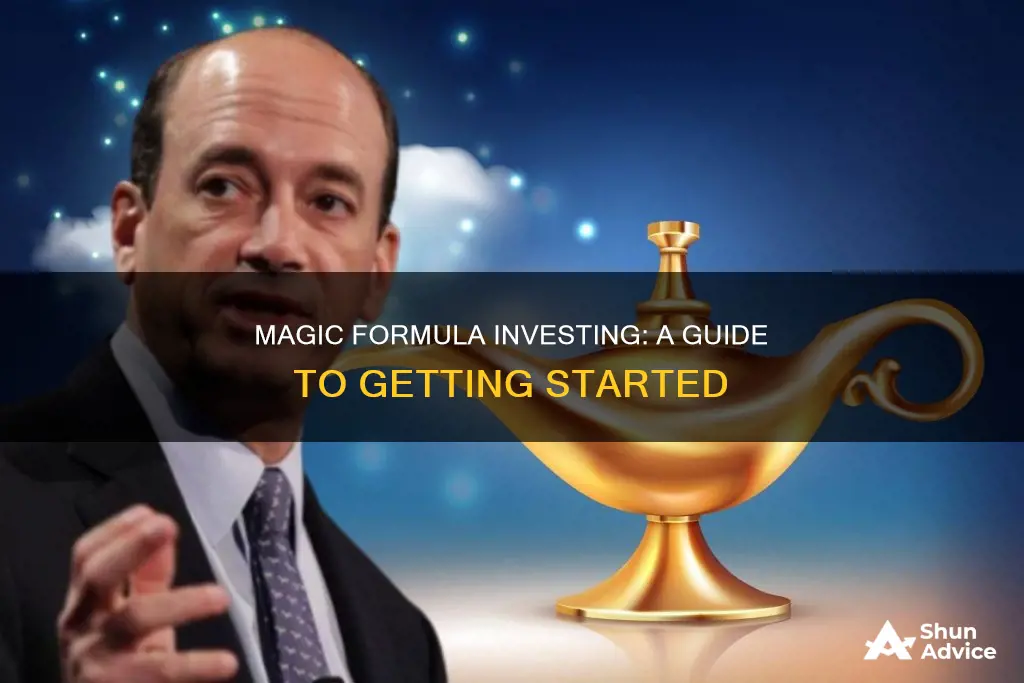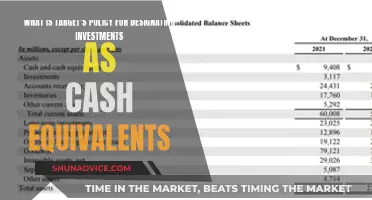
The Magic Formula is an investment strategy created by investor, hedge fund manager, and business professor Joel Greenblatt. It is a rules-based, disciplined investing strategy that teaches people a relatively simple and easy-to-understand method for value investing. The formula is designed to beat the stock market's average annual returns using the S&P 500 to represent the market return. It works by ranking stocks based on their price and returns on capital.
| Characteristics | Values |
|---|---|
| Creator | Joel Greenblatt |
| Investment strategy | Rules-based, value investing |
| Focus | Stock price and company cost of capital |
| Formula | Earnings Yield and Return on Capital |
| Earnings Yield calculation | EBIT ÷ Enterprise Value |
| Return on Capital calculation | EBIT ÷ (Net Fixed Assets + Working Capital) |
| Company exclusions | Financial companies, utilities non-U.S. companies, small-cap stocks |
| Minimum market capitalization | $50 million |
| Number of companies to invest in | 20-30 |
| Portfolio rebalancing | Annually |
| Average annual returns | 30% |
What You'll Learn

Set a minimum market capitalisation threshold
Setting a minimum market capitalisation threshold is a crucial step in the Magic Formula Investing strategy. This step helps to ensure that investors are focusing on companies with sufficient size and liquidity, reducing the risk associated with smaller companies.
The first step in setting the minimum market capitalisation threshold is to determine the starting point. According to Joel Greenblatt, the developer of the Magic Formula, investors should typically set the threshold higher than $100 million. This ensures that the companies being considered have a substantial market presence and are not too small or illiquid. However, Greenblatt also acknowledges that this number can be adjusted based on personal preferences and risk tolerance. For example, he suggests that setting the threshold at $1 billion (large-cap companies) can help minimise volatility.
It is important to note that the Magic Formula strategy specifically excludes small-cap companies and focuses only on large-cap stocks. This is a key distinction of the strategy and is intended to improve the reliability of the selected companies. By setting a higher minimum market capitalisation threshold, investors can further reduce the risk associated with smaller companies, which may have less stable financials or be more susceptible to market fluctuations.
When setting the minimum market capitalisation threshold, it is also essential to consider the number of companies that will be included in the investment portfolio. The Magic Formula strategy typically involves investing in 20 to 30 companies, and setting the threshold too high may result in a limited number of eligible companies. Therefore, investors need to balance the desire for larger, more established companies with the need for a sufficiently diversified portfolio.
Additionally, the minimum market capitalisation threshold should be considered in conjunction with other criteria used in the Magic Formula strategy. For example, the strategy also excludes financial and utility stocks, as well as foreign companies. By combining these criteria with the minimum market capitalisation threshold, investors can further refine their selection of companies to focus on those that meet their specific requirements and risk tolerance.
In summary, setting a minimum market capitalisation threshold is a critical step in the Magic Formula Investing strategy. Investors should consider their risk tolerance, the desired number of companies in their portfolio, and the exclusion criteria when determining the appropriate threshold. By setting an appropriate threshold, investors can focus on larger, more established companies while maintaining a diversified portfolio to help manage risk.
Investing: Negative Cash Flow's Impact and Insights
You may want to see also

Exclude certain securities
Excluding Certain Securities
The Magic Formula Investing strategy requires investors to exclude several categories of investments. These include stocks in the financials and utilities sectors, foreign companies, and American Depositary Receipts (ADRs).
Financial stocks are excluded because they are subject to different regulations and risks than other types of stocks, and they may not be suitable for all investors. Utilities stocks are often considered to be more stable and less volatile than other stocks, but they may also have lower growth potential.
Foreign companies are excluded because they may be subject to different regulatory and market environments, and it may be more difficult for investors to obtain reliable information about them. ADRs are also excluded because they are a way to indirectly own foreign companies that are not traded on U.S. stock exchanges.
By excluding these categories of investments, the Magic Formula Investing strategy aims to focus on stocks that are more likely to meet the specific criteria and provide the desired returns. It is important to note that this exclusionary approach may limit the diversity of an investor's portfolio and could potentially impact the overall performance.
Additionally, when choosing companies to invest in, investors using the Magic Formula must ensure that they only select companies with a market capitalization above a certain threshold, typically $100 million, although this can be adjusted according to personal preferences.
Cash Investments: Now or Later?
You may want to see also

Make the necessary calculations
Once you have a list of companies that meet the criteria outlined in the previous steps, you can start running the numbers. This involves calculating the following metrics for each company:
- Earnings before interest and taxes (EBIT)
- Earnings yield (EBIT divided by enterprise value, which is the company's total value measured by its market capitalization plus total debt minus its cash assets)
- Return on capital (EBIT divided by the sum of net fixed assets and working capital)
Earnings Before Interest and Taxes (EBIT)
This is a measure of a company's profitability. To calculate EBIT, subtract income tax expenses and interest expenses from a company's revenue.
Earnings Yield (EY)
EY is calculated as EBIT divided by enterprise value (EV). EY is used because it targets companies with below-average prices.
Return on Capital (ROC)
ROC is calculated as EBIT divided by the sum of net fixed assets and working capital. The idea behind ROC is to select good companies that are outperforming.
Create Your Rankings
After performing the calculations outlined above, you can rank the companies according to the magic formula. Rank the companies from highest to lowest earnings yield and return on capital. Focus on the top 20 to 30 companies when deciding how to invest.
Using Revocable Trusts for Investing: A Guide
You may want to see also

Create your rankings
Once you've narrowed down your list of companies by setting a market capitalisation threshold and excluding certain securities, you can start ranking companies according to the magic formula.
First, you need to calculate each company's earnings yield and return on capital. To calculate a company's earnings yield, divide its EBIT (earnings before interest and taxes) by its enterprise value (market capitalisation plus total debt minus cash assets). To calculate its return on capital, divide its EBIT by the sum of its net fixed assets and working capital.
Next, rank the companies from highest to lowest earnings yield and return on capital.
Finally, focus on the top 20 to 30 companies when deciding how to invest.
Cash is King: Investing with Cold, Hard Cash
You may want to see also

Start building your portfolio
At the end of the 12-month period, sell off the losing stocks and the winners, being mindful of capital gains tax rules. Then start the cycle over again, using the magic formula rules to select a new crop of stocks to invest in.
Holding stocks for a year before selling at a gain or loss is intended to help maximise your after-tax returns. When you sell stocks at a profit that you've held for longer than a year, you'd be subject to the more favourable long-term capital gains tax rate.
When you're actively investing in stocks, it's important to ask what types of fees you might have to pay. For example, brokers may charge a flat fee for trading stocks or require some commission for every trade. Taking the time to manage investment costs can be beneficial over the long term.
Investing Activities: Do Cash Flows Stay Positive?
You may want to see also







